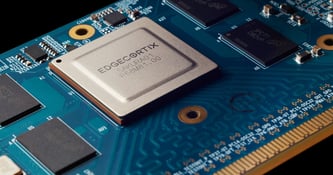Edge AI: Its Critical in Moving Industries – and the World, to a Better Future

Jeffrey Grosman

Article originally posted on Embedded Computing Design.
The way humans interact with technology is changing both in how we use it at work to how we use it in our daily lives.
Edge AI is a unique aspect of technology that is revolutionary because it is bringing the power of artificial intelligence (AI) closer to the source of data generation. Combining the power of edge computing and artificial intelligence, AI algorithms can be executed locally on hardware devices using data collected and processed right at the edge, leading to much higher energy efficiency and shorter processing times (lower latency).
So why is this such an attractive solution for industries like manufacturing, security, aerospace, telecommunications, medical, and more? It’s all about reducing power consumption, reducing the cost of data collection and processing, and increasing accuracy and privacy.
And that’s just the beginning of the benefits that AI processing at the edge can offer. Some key use cases taking advantage of this revolutionary technology today include:
Leveraging Data to Create Smarter Cities:
Distributed sensors can monitor conditions throughout a city – from traffic congestion to air quality concerns and even waste management. Sensors placed throughout a city generate huge volumes of data, which make it difficult for humans to process and make decisions quickly. AI inferencing can efficiently handle routine monitoring, compliance checking, problem identification, and can help determine the best ways to make city operations more productive and less costly. AI systems can also analyze the data at the edge and make quick decisions without interaction with the data center, thus reducing power and increasing efficiency. With more than two-thirds of the world expected to reside in cities by 2050, it’s extremely important to set up effective and efficient smart city infrastructure today to be well poised to take on the future.
Predictive Maintenance in Smart Manufacturing:
Manufacturing is a near-perfect use case of implementing edge AI and other emerging technologies, and use cases are growing. The global AI in manufacturing market was valued at $3.2 billion in 2023 and is poised to grow to $20.8 billion by 2028. As an example, with sensors placed throughout a factory floor, the data generated by these AI infused detection systems can be analyzed early and often, enabling manufacturers to predict when a machine might fail. Sensing an impending repair enables manufacturers to be alerted in real-time to avoid costly downtime. In addition, AI can help recommend changes in manufacturing processes that can reduce manufacturing times and overall production costs.
Advancing Medical Diagnostic Methods:
Applications in healthcare are some of the most awe-inspiring. One of the biggest challenges in the medical field is correctly identifying the exact condition the patient is facing in order to develop the appropriate treatment plan. Examples include identification of cancerous versus benign cells in the body, the monitoring of cardiac activity to predict negative medical outcomes, analyzing the effects and impacts of viruses and many more. The ability of AI to process huge sets of data, and then make recommendations based on this data provides health professionals with invaluable information to help direct their course of action for the best results for their patients. Medical instruments at the edge will eventually become AI-enabled devices that use ultra-low-latency streaming of surgical video to allow for minimally invasive surgeries and insights throughout an entire surgery. According to the National Institute of Health (NIH), while truly autonomous robotic surgery will remain out of reach for some time, synergy across fields will likely accelerate the capabilities of AI in augmenting surgical care.
Energy Forecasting:
Energy forecasting combines many disparate factors to attempt to optimize the loading and performance of energy sources. Modern energy management looks at historical weather data, seasonal energy usage, usage by time of day, the available energy sources (solar, wind, nuclear, coal), and attempts to optimize the usage to minimize costs without experiencing any loss of service to customers. AI models can significantly improve this energy analysis and can create complex simulations that help energy suppliers make informed decisions about generation, distribution, and usage of energy resources in the most efficient way to reduce costs while maintaining continuous service. In an industry critical to maintaining human well-being, edge AI drives better business outcomes for the industry and is expected to reduce global energy consumption by 30% by 2040.
Limitations of Conventional Semiconductors like CPUs and GPUs
General-purpose processing semiconductors like CPUs or GPUs provide developers with flexibility for most applications in the data center. However, these general-purpose solutions don’t always match up well with the needs of the workloads running deep neural networks or generative AI models at the edge. These solutions are highly capable but can operate inefficiently from a performance perspective and can consume excess power, making them untenable for the limited resources and power restrictions in edge applications.
AI Accelerators are the Answer for Efficient Edge AI Processing
In order to tackle some of the most challenging generative AI tasks at the edge, we need solutions designed for flexibility and power efficiency. To seamlessly manage tasks like Large Language Models (LLM), Large Vision Models (LVM), and multi-modal transformer-based applications, low latency, high memory bandwidth, high accuracy, and compact form factors are all key features of an efficient edge AI accelerator that will produce top-performing results. In addition, a full-stack AI inference software environment, run-time reconfigurable edge AI inference IP, and application specific chips, is critical for designers to deploy near cloud-level AI performance at the edge.
Edge AI devices have a wide range of performance and power requirements. So, finding the right accelerator isn’t always an easy decision. AI Accelerators need to support different workloads and deliver the required throughput using popular model inferencing. The edge AI software stack is particularly complex because it includes a compiler capable of optimizing diverse pretrained models to achieve peak hardware utilization (considering memory size as well as memory bandwidth) in different target devices. All too often, hardware providers make software an afterthought. EdgeCortix is one example of a company that took a software-first approach to designing a novel AI-specific runtime reconfigurable processor. This software-first approach allows developers to better configure software and the underlying hardware to match the specific computing needs of each specific application.
A New Era of Computing
The era of non-data center applications leveraging cloud connectivity and high-power GPU devices to perform AI inferencing has become impractical at the edge. Large time delays (latency) while waiting for responses from the cloud and the high-power consumption inherent in existing data-center designs likely does not meet the performance and power requirements for edge-based computing. This is leading to a desire for solutions with much higher efficiency given the limited memory resources and power availability for edge applications and is driving the need for solutions that offer high responsiveness, reduced power consumption, and efficient processing to meet these stringent edge requirements. Purpose built AI Accelerators are the best and most efficient solution for edge AI processing, offering the ideal combination of performance and power efficiency. AI Accelerators can solve these edge challenges in all manner of business applications including smart city, smart manufacturing, medical applications, energy forecasting and many other uses. The key is finding a solution that most directly matches with your unique power, latency and processing requirements.
When considering the challenges that processing AI tasks at the edge can present, from data privacy and security; to network connectivity; scalability; model optimization; and integration with existing systems, it’s critical to apply solutions that solve these challenges irrespective of the business sector or industry. Through careful planning, the right partnerships, and diligent execution, organizations can tap into the power of edge AI to unlock new business capabilities and opportunities for themselves and their end customers.

Jeffrey Grosman
Jeffrey is EdgeCortix’s Executive VP of Marketing & US Operations. Prior to joining EdgeCortix, he brings over three decades of experience in marketing, branding, management, and operations leadership roles with world-class companies while leading them through rapid growth and large-scale transformation. Jeffrey holds an MBA from Emory University and an undergraduate degree with a dual major in Computer Science and Sociology from Rutgers University.
Related Posts


What is edge AI inference doing for more devices?
